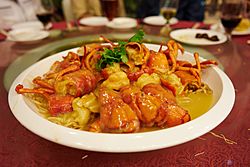Yi mein facts for kids

Lobster with E-Fu Noodle in Hong Kong
|
|
| Alternative names | E-fu noodles, yee-fu noodles, yi noodles, yifu noodles |
|---|---|
| Type | Chinese noodles |
| Place of origin | China |
| Main ingredients | Wheat flour, eggs |
| Yi mein | |||||||||||||||||||
|---|---|---|---|---|---|---|---|---|---|---|---|---|---|---|---|---|---|---|---|
| Chinese | 伊麵 | ||||||||||||||||||
|
|||||||||||||||||||
| Alternative Chinese name | |||||||||||||||||||
| Chinese | 伊府麵 | ||||||||||||||||||
|
|||||||||||||||||||
Yi mein (Chinese: 伊麵; pinyin: yī miàn; Cantonese Yale: yī mihn) are a special type of Chinese noodles. They are flat, golden-brown, and made from wheat flour and eggs. These noodles are famous in Cantonese cuisine.
What makes Yi mein unique is their chewy and slightly bouncy texture. This special texture comes from using soda water when making the dough. After mixing, the dough is fried and then dried into flat, brick-like shapes.
Contents
How Yi Mein Noodles Are Made and Cooked
Most Yi mein noodles you find in stores are already pre-cooked. Machines cook them in a similar way to how instant noodles are made today. This means they are ready to be prepared quickly at home.
Cooking Your Yi Mein
You can cook Yi mein in many ways. First, you usually boil them. After boiling, you can stir-fry them with other ingredients. They are also great in soups or even in salads. Good Yi mein noodles will stay stretchy and chewy, no matter how you cook them.
Popular Yi Mein Dishes
Yi mein noodles are very versatile. They can be eaten on their own or used in many delicious dishes. Here are some popular ways to enjoy them:
- Plain Yi Mein: Simple and tasty, often served as a side dish.
- Yi Mein with Chinese Chives: This dish adds a mild onion-like flavor from Chinese chives.
- Dried Fried Yi Mein: A classic stir-fried version, often with Chinese chives and shiitake mushrooms.
- Crab Meat Yi Mein: Noodles mixed with delicious crab meat.
- Lobster Yi Mein: A fancy dish, sometimes served with cheese in Hong Kong.
- Yi Mein with Mushrooms and Eggplant: A vegetarian option with earthy flavors.
- Yi Mein in Soup: Served in a warm, comforting broth.
- I Fu Mie: A dried fried Yi mein dish from Indonesia, served with sauce, vegetables, chicken, or shrimp.
Yi Mein and Special Traditions
Yi mein noodles are more than just food; they are part of special traditions. When people eat Yi mein on birthdays, they are often called longevity noodles or sau mein (壽麵/寿面). The Chinese word for "long" is added to show that they represent a "long life." People often eat them with longevity buns during these celebrations.
Gallery
See also
 In Spanish: Yi mein para niños
In Spanish: Yi mein para niños





